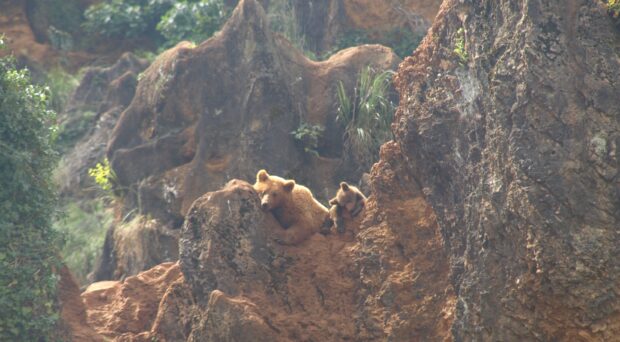
The One Health Approach is very topical at the moment, with a lot of research and intersectoral work addressing emerging infectious diseases, zoonoses, food security and environmental stressors that have strong human health implications. Yet One Health also applies to our wildlife and conservation efforts to ensure the wellbeing and good health of our wild animals.
In a recent study in Spain, researchers looked at the helminth parasites infecting the brown bear, Ursus arctos, population in the Cantabrian Mountains, also know as the Cantabrian Bears. Spain almost lost its bear population, with numbers plummeting to 60 or 70 individuals in the 1990s. Thanks to efforts to protect the bears, listed as critically endangered in Spain and Europe, through Spain’s strategy for the conservation of the brown bear in the Cantabrian Mountains, numbers have climbed back up, with an estimated population of around 300 individuals. Conservation efforts are focused on monitoring these populations and addressing challenges around human-bear contact, ecosystem modification or degradation and risks to bear health.
The study objectives were to understand which helminth parasites infect this small and endangered bear population, identify any seasonal variations in parasite prevalence and determine if bear activity periods (hibernation, mating and hyperphagia) influenced parasite prevalence.
Finding parasitic worms in bears
Researchers working with the local Bear Patrol collected 248 bear faecal samples between August 2018 and September 2019. These samples were examined for:
- Eggs of cestodes and gastrointestinal nematodes using the flotation technique, and the McMaster chamber for egg counting
- Trematode eggs using the sedimentation technique and McMaster chamber for egg counting
- Broncopulmonary larvae using the larval migration technique and the Favati chamber for larval counting
All data was analysed based on season: Spring, Summer, Autumn, Winter.
And by bear activity periods:
- Hibernation (January to mid-April)
- Mating (mid-April to June)
- Hyperphagia (July to December, a period where they eat 2-3 times their normal amount to prepare for hibernation)
Overall, 64.1% of faecal samples test positive for parasites.
- Baylisascaris spp in 44.8% (roundworm nematodes)
- Dicrocoelium dendriticum (a trematode, typically residing in the gall bladder and bile ducts of cattle, sheep and ungulates) was found in 32.2%
- Ancylostomatids (hookworms nematodes) in 16.5%
- Trichuris sp (whipworm nematodes) in 1.3%
Parasite patterns by season and bear activity.
Seasonality: The authors reported evidence of seasonality for Baylisascaris and ancylostomatid prevalences, with low prevalence in winter, increasing to their highest prevalence in autumn. Seasonality also impacted infection intensities for Dicrocoelium, Baylisascaris and ancylostomatids.
Bear activity: Dicrocoelium was most prevalent during the mating period. Baylisascaris was most prevalent during the hyperphagia period. Baylisascaris infection intensities were also significantly different across bear activity periods with the highest egg outputs observed in the hibernation period.
Although Dicrocoelium dendriticum is more commonly found in ungulates, the authors highlight that the second intermediate host of this fluke are ants, and ants are an important seasonal source of food for brown bears. However, the authors highlight that more research is needed to understand when and how transmission happens in bears, to understand bear behaviour and source of transmission.
Baylisascaris and ancylostomatids are characterized by free-living phases of their lifecycle where larval stages develop into their next infective life stage in the soil. Infection prevalences being highest during the hyperphagia period could be due to increased exposure and ingestion during this period.
The authors conclude that both seasonality and bear activity influence these hepatic and intestinal parasite species, and that a greater understanding of bear behaviour and risks to their health can be achieved by studying the parasite populations in these protected populations. Further studies using molecular techniques to identify species, and epidemiological work to look at transmission sources are needed to safeguard these bears.

Comments